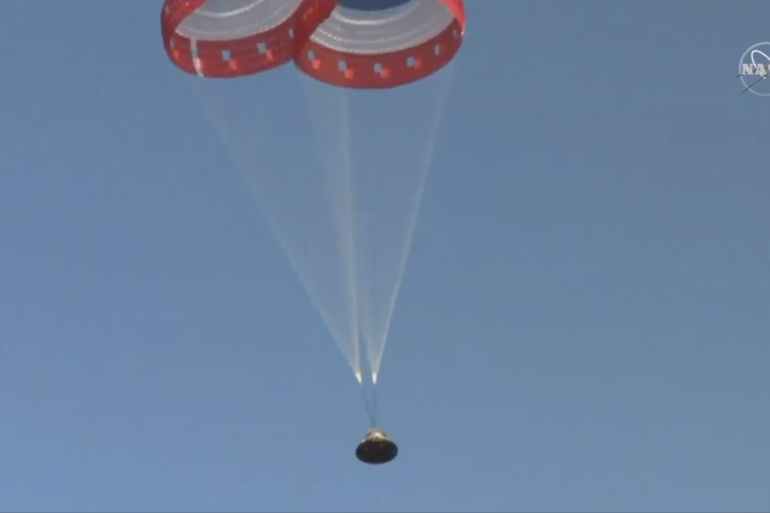Boeing’s key test of Starliner space capsule is mostly successful
Joint operation with NASA shows aerospace giant is getting on track to transport crew to International Space Station.

With an anthropomorphic test dummy on board, Boeing executed a critical “pad abort test” on Monday to show that the company’s space capsule can save the lives of astronauts in case of an emergency during future launches.
This first Starliner test flight was successful, but with a slight snag.
Keep reading
list of 4 itemsPhotos: Mexico, US, Canada mesmerised by rare total solar eclipse
Moment total solar eclipse occurs in North America
Millions across North America await total solar eclipse
Boeing astronaut Chris Ferguson and NASA astronauts Nicole Mann and Michael “Spanky” Fincke observed the test, which certified that each of the Boeing Starliner’s launchpad safety systems can perform seamlessly together.
In the unlikely event of an emergency, the Starliners can whisk the crew capsule away from the launchpad after being disconnected from the top of a rocket.
“We hope to never need to use this system,” said Fincke, a three-time NASA veteran astronaut.
“But in case we ever have any trouble aboard the beautiful Atlas V [rocket] on the launchpad, we know that after today’s test we’ll be able to get off safely and then come back and try again a different day,” Fincke added.
Reviewing the data
The test, launched at 6:16am (13:16 GMT) at the United States Army’s White Sands Missile Range in southern New Mexico, is a milestone achievement for Boeing and its Crew Space Transportation (CST)-100 Starliner craft.
While unintentional, the test demonstrated that the capsule’s redundant systems are effective. Just two of the three main parachutes atop the capsule deployed to reduce the speed of the spacecraft’s descent.
In a press statement issued later on Monday, Boeing said, “We will review the data to determine how all of the systems performed, including the parachute deployment sequence”.
“We did have a deployment anomaly, not a parachute failure,” Boeing added. “It’s too early to determine why all three main parachutes did not deploy. However, having two of three deploy successfully is acceptable for the test parameters and crew safety.”
Boeing’s Starliner is a part of NASA’s Commercial Crew Development (CCDev) programme, which has experienced repeated delays.
CCDev is years behind schedule, despite awarding more than $8.2bn in Space Act Agreements and contracts – with Boeing accounting for $4.82bn and its competitor, SpaceX, garnering roughly $3.15bn.
‘Great launch vehicle’
Among other challenges for the company, Boeing’s next critical space demonstration is scheduled for next month, when it hopes to launch an uncrewed Starliner craft on a United Launch Alliance Atlas V rocket – in what is called an Orbital Flight Test, or OFT.
Boeing and the United Launch Alliance believe the Starliner OFT will prove in December that the Atlas V rocket’s Emergency Detection System is capable of detecting launch abnormalities – which could then trigger a mission-abort sequence to rescue astronauts in a failed sequence.
NASA had hoped two years ago that either the Starliner or SpaceX’s Crew Dragon would already be in the business of ferrying astronauts to and from the International Space Station (ISS).
But with each delay, costs for NASA – and for US taxpayers – have risen in other ways.
Since NASA decommissioned the Space Shuttle Program in 2011, the agency has shelled out roughly $85m a seat to Roscosmos, formerly known as Russia‘s Federal Space Agency, to get its astronauts a ride on board Soyuz rockets headed to the ISS.
The cost for a similar ticket on the Starliner or Crew Dragon is estimated to be about $50m.
Last week, the Russian News Agency TASS reported that Roscosmos Director-General Dmitry Rogozin has instructed his agency to construct two additional Soyuz crewed spaceships in anticipation of further delays.
“We really appreciate our friends in Russia, for having the launch vehicle on the Soyuz. I flew on it twice,” said Fincke. “It’s a great launch vehicle, a great spacecraft. But it’s time to have more options.”